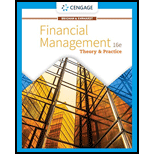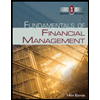
1)
Case summary:
Person X is a graduate, who is working as a financial planner at company C. The president and congress involved in the dispute of acrimonious over the financing of debt and budget. The dispute which is not settled at the end of the year and effected the rate of interest.
The responsibility of person X is to compute the risk of bond portfolio of client. Person X should explain the probable scenarios for the dispute resolution and compute
To discuss: The manner in which impact of portfolio influence the investors think related to risk of single stocks.
2)
Case summary:
Person X is a graduate, who is working as a financial planner at company C. The president and congress involved in the dispute of acrimonious over the financing of debt and budget. The dispute which is not settled at the end of the year and effected the rate of interest.
The responsibility of person X is to compute the risk of bond portfolio of client. Person X should explain the probable scenarios for the dispute resolution and compute rate of return for 10 year zero coupon treasury bond for each cases.
To discuss: Whether person X expects to compensate all of his risk while earning risk premium on part of your risk and can removed by diversifying.
Want to see the full answer?
Check out a sample textbook solution
Chapter 6 Solutions
Financial Management: Theory & Practice
- Market equity beta measures the covariability of a firms returns with all shares traded on the market (in excess of the risk-free interest rate). We refer to the degree of covariability as systematic risk. The market prices securities so that the expected returns should compensate the investor for the systematic risk of a particular stock. Stocks carrying a market equity beta of 1.20 should generate a higher return than stocks carrying a market equity beta of 0.90. Nonsystematic risk is any source of risk that does not affect the covariability of a firms returns with the market. Some writers refer to nonsystematic risk as firm-specific risk. Why is the characterization of nonsystematic risk as firm-specific risk a misnomer?arrow_forwardYou have been hired at the investment firm of Bowers Noon. One of its clients doesnt understand the value of diversification or why stocks with the biggest standard deviations dont always have the highest expected returns. Your assignment is to address the clients concerns by showing the client how to answer the following questions: d. Construct a plausible graph that shows risk (as measured by portfolio standard deviation) on the x-axis and expected rate of return on the y-axis. Now add an illustrative feasible (or attainable) set of portfolios and show what portion of the feasible set is efficient. What makes a particular portfolio efficient? Dont worry about specific values when constructing the graphmerely illustrate how things look with reasonable data.arrow_forwardYou have been hired at the investment firm of Bowers & Noon. One of its clients doesn’t understand the value of diversification or why stocks with the biggest standard deviations don’t always have the highest expected returns. Your assignment is to address the client’s concerns by showing the client how to answer the following questions: What is the Capital Asset Pricing Model (CAPM)? What are the assumptions that underlie the model? What is the Security Market Line (SML)?arrow_forward
- What is a characteristic line? How is this line used to estimate a stocks beta coefficient? Write out and explain the formula that relates total risk, market risk, and diversifiable risk.arrow_forwardWhat should be the risk premium and return on a stock with a Beta of zero under the Capital Asset Pricing Model (CAPM)? What about the risk premium and return on a stock with a Beta of 1? In a world of certainty, investors will always invest in the asset with the highest return. In the real world, investors hold a diversified portfolio of securities. Why is this the case? Theoretically, returns on stocks or assets can be negatively correlated. In the real world, however, we usually encounter only positive correlations. Whymay this be the case?arrow_forwardWhen all investors have the same information and care only about expected return and volatility; if new information arrives about one stock, can this information affect the price and return of other stocks?arrow_forward
- This question relates to the two types of risk and to diversification. a)What is specific risk? b)What is market risk? c)What is meant by diversification? d)Explain why diversification is a useful tool to manage specific risk but not market risk. Be sure you answer clearly both why diversification can help manages specific risk as well as why it is not useful in managing market risk. e)Approximately how many stocks in a portfolio do you need to be fully diversified?arrow_forwardWhich one of the following expressions about risk and returns is wrong? A. In general, one reason why a stock is riskier than a bond is that because cash flows from a bond are known and promised, whereas cash flows from a stock are neither known nor promised. B. According to CAPM model, a well-diversified portfolio will have a beta which equals to 0. C. Risk premium is the extra return provided on risky assets to compensate for risk. The difference between risky return and the risk-free return. D. Unexpected return happened because new information came to light which caused our expectations about prices and returns to change.arrow_forwardWhich of the following statements is CORRECT? a. Portfolio diversification reduces the variability of returns on an individual stock. b. Risk refers to the chance that some unfavorable event will occur, and a probability distribution is completely described by a listing of the likelihood of unfavorable events. c. The SML relates a stock's required return to its market risk. The slope and intercept of this line cannot be controlled by the firms' managers, but managers can influence their firms' positions on the line by such actions as changing the firm's capital structure or the type of assets it employs. d. A stock with a beta of −1.0 has zero market risk if held in a 1-stock portfolio. e. When diversifiable risk has been diversified away, the inherent risk that remains is market risk, which is constant for all stocks in the market.arrow_forward
- Which of the following statements related to risk is (are) true: (i) Beta measures risk that cannot be diversified. (ii) As more shares are included in a portfolio the total risk of that portfolio goes down. (iii) Investors are normally risk averse and, therefore, they demand a risk premium.arrow_forwardIf you decide to invest in both stocks and bonds, which has a greater percentage, how will you diversify your risks?arrow_forwardq1- Which of the following statements about the difference between investing in a large portfolio and investing in individual shares is true? Select one: a. For a given level of risk, an investment in a large portfolio will have less return than an investment in a single share. b. For a given level of return, an investment in a large portfolio will have less risk than an investment in a single share. c. For a given level of return, an investment in a large portfolio will have more risk than an investment in a single share. d. We cannot draw any firm conclusions. For a given level of return, Individual shares may have more or less risk than a large portfolio, depending on the individual share and depending on the portfolio.arrow_forward
 Intermediate Financial Management (MindTap Course...FinanceISBN:9781337395083Author:Eugene F. Brigham, Phillip R. DavesPublisher:Cengage Learning
Intermediate Financial Management (MindTap Course...FinanceISBN:9781337395083Author:Eugene F. Brigham, Phillip R. DavesPublisher:Cengage Learning
 EBK CONTEMPORARY FINANCIAL MANAGEMENTFinanceISBN:9781337514835Author:MOYERPublisher:CENGAGE LEARNING - CONSIGNMENT
EBK CONTEMPORARY FINANCIAL MANAGEMENTFinanceISBN:9781337514835Author:MOYERPublisher:CENGAGE LEARNING - CONSIGNMENT Financial Reporting, Financial Statement Analysis...FinanceISBN:9781285190907Author:James M. Wahlen, Stephen P. Baginski, Mark BradshawPublisher:Cengage Learning
Financial Reporting, Financial Statement Analysis...FinanceISBN:9781285190907Author:James M. Wahlen, Stephen P. Baginski, Mark BradshawPublisher:Cengage Learning Fundamentals of Financial Management (MindTap Cou...FinanceISBN:9781285867977Author:Eugene F. Brigham, Joel F. HoustonPublisher:Cengage Learning
Fundamentals of Financial Management (MindTap Cou...FinanceISBN:9781285867977Author:Eugene F. Brigham, Joel F. HoustonPublisher:Cengage Learning




